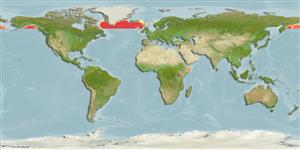Environment: milieu / climate zone / depth range / distribution range
Sinh thái học
Biển Tầng nổi biển sâu; Mức độ sâu 500 - 7625 m (Ref. 58426), usually 1200 - 1400 m (Ref. 559). Deep-water; 67°N - 56°N, 180°W - 180°E
Circumglobal: In tropical to temperate waters. Eastern Pacific: ranges from northern California to Peru (Ref. 35600).
Bộ gần gũi / Khối lượng (Trọng lượng) / Age
Maturity: Lm ? range ? - ? cm
Max length : 100.0 cm TL con đực/không giới tính; (Ref. 27000); common length : 55.0 cm NG con đực/không giới tính; (Ref. 5755)
Các tia vây lưng cứng (tổng cộng) : 0; Tia cứng vây hậu môn: 0. Mouth greatly enlarged by a backward extension of jaws, gape comprising half or more of preanal length; buccal cavity greatly distensible. Tail attenuated and ending in an expanded, luminous caudal organ. Caudal fin absent; scales absent; lateral line without pores, instead with groups of elevated tubules.
Meso- to abyssopelagic (Ref. 58302) and bathypelagic (Ref. 58426). Adults feed mainly on crustaceans, but also take fishes, cephalopods, and other invertebrates (Ref. 2850, 11041). Oviparous, planktonic eggs hatch into planktonic leptocephalus larvae (Ref. 6719, 35600). Degenerative changes in males and females suggest semelparity (Ref. 35600).
Life cycle and mating behavior
Chín muồi sinh dục | Sự tái sinh sản | Đẻ trứng | Các trứng | Sự sinh sản | Ấu trùng
Oviparous (Ref. 35600). Degenerative changes in males and females suggest semelparity (Ref. 35600). Egg cells within each of the gonads have the same developmental stage (monocyclic ovaries) suggesting only one spawning during its lifetime or periodic spawning (Ref. 36055).
Nielsen, J.G. and E. Bertelsen, 1990. Eurypharyngidae. p. 206. In J.C. Quero, J.C. Hureau, C. Karrer, A. Post and L. Saldanha (eds.) Check-list of the fishes of the eastern tropical Atlantic (CLOFETA). JNICT, Lisbon; SEI, Paris; and UNESCO, Paris. Vol. 1. (Ref. 4457)
IUCN Red List Status (Ref. 130435: Version 2024-2)
Threat to humans
Harmless
Human uses
Các nghề cá: không ích lợi (thú vị)
Các công cụ
Special reports
Download XML
Các nguồn internet
Estimates based on models
Preferred temperature (Ref.
123201): 2.3 - 5.5, mean 3.6 °C (based on 890 cells).
Phylogenetic diversity index (Ref.
82804): PD
50 = 1.5000 [Uniqueness, from 0.5 = low to 2.0 = high].
Bayesian length-weight: a=0.00102 (0.00046 - 0.00225), b=3.06 (2.88 - 3.24), in cm total length, based on all LWR estimates for this body shape (Ref.
93245).
Mức dinh dưỡng (Ref.
69278): 4.1 ±0.57 se; based on food items.
Thích nghi nhanh (Ref.
120179): Rất thấp, thời gian nhân đôi của chủng quần tối thiểu là hơn 14 năm (Assuming semelparity with tm>10).
Fishing Vulnerability (Ref.
59153): High vulnerability (60 of 100).
Nutrients (Ref.
124155): Calcium = 15.6 [4.0, 64.6] mg/100g; Iron = 0.408 [0.125, 1.243] mg/100g; Protein = 2.94 [0.00, 6.86] %; Omega3 = 0.192 [0.063, 0.599] g/100g; Selenium = 18.7 [6.0, 72.0] μg/100g; VitaminA = 28.8 [3.8, 214.8] μg/100g; Zinc = 0.453 [0.206, 1.092] mg/100g (wet weight);
